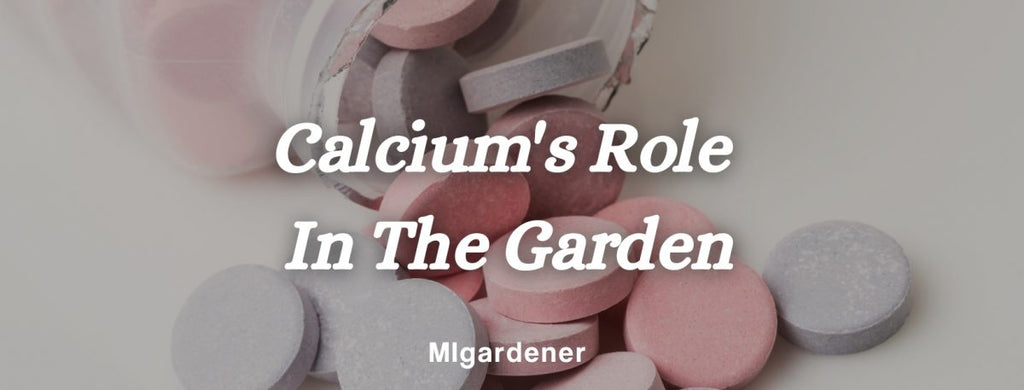
Your Garden Would Be Nowhere Without Calcium
Written by - Kaitlynn & Luke from MIgardener
Calcium is one of the most overlooked minerals in the garden because most people assume their soil is already rich with it. Here in the North, gardening season is coming to a halt. Cooler temperatures are just around the corner, making this the perfect time of year to refresh on the basics of good gardening practices. Today we will learn all about calcium and why it is vital for every garden's success.
Let's get started!
What Is Calcium

Calcium is an essential mineral for the sustaining of life! All life forms require calcium to keep things going, but plants, in particular, need more than most mammals. Calcium is most commonly found in limestone, a rock formed from marine animals' skeletal fragments like mollusks and coral. Calcium carbonate is the form of calcium that plants in the garden can uptake. Seashells, gypsum, plants, Eggshells, even our teeth, bones, and hair are made of Calcium carbonate. Your plants will know how much calcium they can use, so there's no way to add too much calcium to the soil. Studies have shown an association between plant and fruit size to the amount of calcium found in the soil.
The Role of Calcium In The Garden

We all have an idea of what calcium does for our bodies. Calcium keeps our bones strong, helps our blood clot, and allows our muscles to contract. For plants in the garden, calcium does something similar. Calcium is responsible for building a strong cell structure. Just like our bones, cell structure keeps our plants strong and standing tall. Strong plants make the best fruit. When the cell walls are sturdy, it allows the fruit to be more secure on the vine. Calcium also acts as a growth regulator for plants by working hand in hand with Nitrogen in the soil to promote healthy growth.
Calcium will also help to regulate the flow of nutrients around the entire plant. When calcium is present in the soil, it helps the plant uptake other nutrients every time it is watered. Basically, calcium is an essential building block, almost like the gatekeeper your plant requires to let all of the other good stuff in. For more on how to use calcium in the garden, click here.
Signs Of Calcium Deficiency

The first sign of a calcium deficiency is pitting on the undersides of leaves. The leaves will begin curling upward and may even crack. This is because the leaf cannot stretch, and it bends and curls, trying to work around the deficiency. In more noticeable cases commonly seen when growing tomatoes, the fruit will get a black spot at the flower end. This is called "blossom end rot." This can happen with any fruit or vegetable and is very easily fixed. To learn a quick and easy technique for fighting blossom end rot, click here.
The Best Forms Of Calcium For the Garden
There are a few garden products sold specifically to add calcium to the soil, but here are a few that are much easier to get your hands on. If you are looking for a one-and-done product, Trifecta+ has all the nutrients your garden will need to kick off the growing season.
Leaf/Lawn waste - When composted, lawn waste contains about 9% Ca by weight.
Sea Shells- When crushed, any shell contains around 70% Ca by weight.
Antacid tablets - In an emergency, antacid tablets are pure Ca at around 97% Ca by weight.
Crushed gypsum - A slow-release but highly effective at breaking up clay soil and providing around 45% Ca by weight.
Eggshells - When crushed, Eggshells are a slow-release form but free and contain about 70% Ca by weight.
Did you enjoy this post? MIgardener is passionate about sharing free gardening tips and information! If you are looking for inspiration in the garden, make sure to check out our Pinterest page. New ideas and inspiration can be found there at any time. Check us out at MIgardener.com or on youtube, Instagram, and Facebook.
Love your videos and have followed you since early days, so I thought I’d offer something back. I live in Saskatchewan. Very alkaline soil and unyielding blossom end rot for years. I know some areas of the US have similar challenges. Even calcium didn’t help no matter the form. I thought you might be interested in the solution. No gardening sites could offer any solution but for calcium which year over year over year wasn’t working. I found the solution on a government site for large scale farming. In alkaline soil, calcium and salts compete for uptake by the plant. The salts win. I added aluminum sulphate based on annual testing of the soil in my raised beds. Once at the beginning of the season two weeks before planting and side dressing when the plant starts to fruit. Voila! Rarely do I lose a tomato or zucchini now.
I learned recently that eggshells or other forms of calcium that are slow releasing has a quick fix as well…Vinegar can be poured over crushed eggshells and left to sit for about an hour….Vinegar contains Acetic acid….and acetic acid chemically combines with calcium carbonate to form calcium acetate…..this form of calcium can be used by your plants immediately….over the hour….the eggshells will lightly bubble….the gas released is carbon dioxide…and that’s how you can tell that the mixture is combining….just pour the liquid (only a small amount….around a quarter cup to a bowl of eggshells…into a can ndd mix with a gallon of water to immediately water into your plants’ roots.
I’ve used trifecta two years in a row now and each year my tomatoes got bottom rot.
Leave a comment